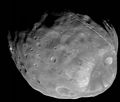Податотека:Phobos colour 2008.jpg

Големина на овој преглед: 636 × 600 пиксели. Други разделности: 255 × 240 пиксели | 509 × 480 пиксели | 815 × 768 пиксели | 1.086 × 1.024 пиксели | 2.172 × 2.048 пиксели | 3.500 × 3.300 пиксели.
Изворна податотека (3.500 × 3.300 пиксели, големина: 2,72 МБ, MIME-тип: image/jpeg)
Историја на податотеката
Стиснете на датум/време за да ја видите податотеката како изгледала тогаш.
| Датум/време | Минијатура | Димензии | Корисник | Коментар | |
|---|---|---|---|---|---|
| тековна | 05:10, 2 април 2018 |  | 3.500 × 3.300 (2,72 МБ) | Kaldari | more margin on right side |
| 06:47, 13 ноември 2008 |  | 3.374 × 3.300 (2,7 МБ) | Fir0002 | == Summary == {{Information |Description=Colour image of Phobos, imaged by the Mars Reconnaisance Orbiter in 2008 |Source=NASA |Date=9 April 2008 |Location=http://www.nasa.gov/mission_pages/MRO/multimedia/pia10368.html |Author=NASA/J |
Употреба на податотеката
Податотекава се користи во следниве 7 страници:
Глобална употреба на податотеката
Оваа податотека ја користат и следниве викија:
- Употреба на af.wikipedia.org
- Употреба на an.wikipedia.org
- Употреба на ar.wikipedia.org
- المريخ
- فوبوس
- قمرا المريخ
- ويكيبيديا:صور مختارة/الفضاء والكون/نظرة إلى الأعلى
- قائمة أجرام المجموعة الشمسية مرتبة حسب الحجم
- بوابة:علم الفلك/صورة مختارة
- بوابة:المريخ
- بوابة:المريخ/مقالة مختارة/أرشيف
- بوابة:المريخ/مقالة مختارة/2
- قائمة الأقمار الطبيعية
- خط زمني لاكتشاف كواكب المجموعة الشمسية وأقمارها
- ويكيبيديا:ترشيحات الصور المختارة/القمر فوبوس
- ويكيبيديا:صورة اليوم المختارة/أغسطس 2019
- قالب:صورة اليوم المختارة/2019-08-03
- بوابة:علم الفلك/صورة مختارة/73
- معسكر قاعدة المريخ
- ويكيبيديا:صورة اليوم المختارة/يناير 2022
- قالب:صورة اليوم المختارة/2022-01-04
- Употреба на ary.wikipedia.org
- Употреба на arz.wikipedia.org
- Употреба на as.wikipedia.org
- Употреба на azb.wikipedia.org
- Употреба на az.wikipedia.org
- Употреба на be-tarask.wikipedia.org
- Употреба на be.wikipedia.org
- Употреба на bg.wikipedia.org
- Употреба на bh.wikipedia.org
- Употреба на bn.wikipedia.org
- Употреба на bn.wikibooks.org
- Употреба на bs.wikipedia.org
Погледајте ја останатата глобална употреба на податотекава.





